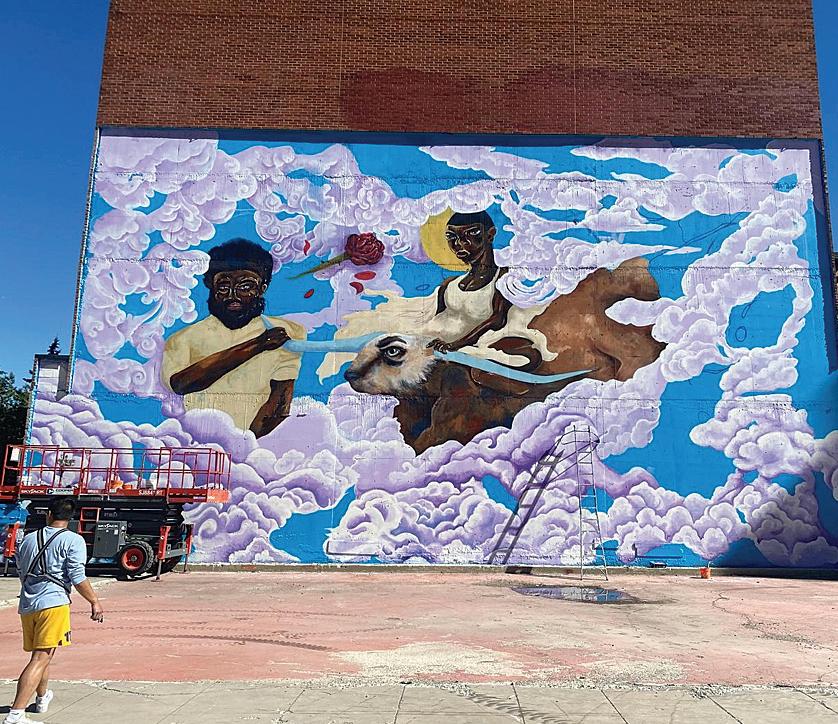
5 minute read
Artist Jae Sterling helps guide and
COVER Calgary’s Jae Sterling is helping guide and protect with his art CYANA ANDALIS

candalis@cjournal

Jae Sterling, musician and visual artist, began showcasing his paintings to support the Black Lives Matter movement. PHOTO: SIERRA STONE
Jae Sterling and his group “SANSFUCCS’,’ a multidisciplinary art collective, had just nished their music tour around Eastern Canada right when the pandemic hit. Like everyone else, they were on lockdown for a few months. Sterling says this situation was quite discouraging, and he felt a lack of interest in doing shows online. However, being stuck at home opened other doors for him.
While there, Sterling picked up his paintbrush and started painting again. His subjects were his family members, who were of Jamaican descent. Sterling says that he didn’t intend to turn his art into political pieces. But, with the resurgence of the Black Lives Matter movement, art that honoured Black people took on a political meaning
Sterling’s manager took notice and suggested he showcase his paintings. Amidst social distancing restrictions, Sterling’s exhibition – named “Riding Horses with White Men” – was held at NVRLD Gallery in Calgary.
It was there that Sterling was approached by Pink Flamingo, a Black-led advocacy organization that uplifts the QTBIPOC community in Calgary, to paint a Black Lives Matter mural downtown.
Earlier in the year, Pink Flamingo had received public money to paint four BLM murals around the city. But the location of the first one — on the current Giving Wings to the Dream site — provoked backlash and hate. They put the public project on pause, but subsequently raised private funds for a new mural at a new site near the Calgary Chinese Cultural Centre.
Sterling’s work, which was completed this fall, is called The Guide and Protector and features pioneering Black cowboy John Ware.
Working on the mural, Sterling said he received racist comments to the point of feeling unsafe. The level of scrutiny was alarming.

Black history on display in Chinatown: “The Guide and Protector” mural. PHOTO: PRIYA RA
> Jae Sterling
“It felt like a bunch of people came into my house at once,” Sterling said. “That took a lot of getting used to — I expected press, but I didn’t expect drones, didn’t know who was sending them. Politicians started rolling through like crazy as well. It was very weird.”
Being threatened due to racism wasn’t new to Sterling. After moving from Jamaica to Canada, he found himself being mistreated because of the colour of his skin. The discrimination worsened as a result of his work on the mural. However, he continued to feel bold and empowered despite what people were saying about his art.
The choice to depict a cowboy seemed to be a natrural fit. “This is where Stampede is. It would be weird for me to not acknowledge that in the mural. I was already imagining something western with cows and bulls,” says Sterling.
“Then I learnt about John Ware, the first black cowboy to come to Calgary, so that brought everything together for me. I added the longhorns to the bull after finding out about him.”
However, Sterling never imagined that painting a mural with good intentions behind it — such as creating awareness for The Black Lives Matter movement and honouring the BIPOC community in Calgary – would become so controversial.
“I’d be lying to you if I said hurtful words didn’t hurt me. But what helps me is to not pay attention to the negativity and just focus on the people that it helps, because at the end of the day that is more important — it is bigger than me.” Since he and his family left their home in Jamaica when he was 19, Sterling was faced with encounters from people who target him due to his racial profile. He explains there’s been times where some co-workers who were having a bad day found it best to retaliate and project their hate and anger towards Sterling for no reason.
“A lot of people who migrate here can testify to what I’m saying: that a lot of racial discrimination happens in the workplace. Your first instinct isn’t to call racism because you might lose your job, especially when your boss is white.” Sterling says. “So that just makes you want to be quiet, so you can keep your job, but that builds up within you.”
As a result, Sterling believes that Canada is often misunderstood as a safe country with less racial discrimination. Sterling says that he believes that people should have the courage to speak up more to draw more awareness around this issue.
“Many people are sharing, and you hear about how much people have been going through racial inequality and keeping quiet about it. For people to say that Canada doesn’t have racial discrimination — I would say, look back on that, because maybe we actually shouldn’t silence people.”
However, instead of retaliating against that racism, Sterling explains that he’d rather take the high road.
“But I hope that those who are against this see the mural, and it breaks their matrix. Then they realize how they’ve never actually had anyone challenge them before, and they start asking questions, wondering why they hate it so much.”
Now that the mural is up, Sterling hopes “The Guide and Protector” inspires the city and provokes change. Sterling also hopes that he can continue with his life, after being the artist behind Calgary’s first Black Lives Matter mural.
“I hope that I can just paint. We can have a conversation about art without a huge political twist. I’m proud of what my work has done, but I really don’t want to feel that unsafe for the rest of my life, you know?”
As the Black Lives Matter Movement grows, Sterling hopes the increased awareness of racial inequality will change that.
“You know that we’re here, meaning black people, and we are very talented, and we deserve to be able to put up art in this city without controversy, hopefully one day that will be the case as much as it means something. And it’s so powerful.”










